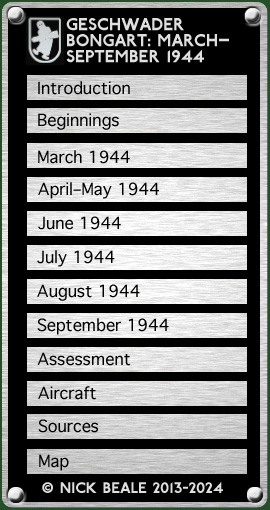|
Luftflotte 3 passed on a request for operations against insurgents dug-in north west of Romans, who were said to have been supplied by the RAF during the night of 9–10 June. The Army was using tanks against them but the terrain was unfavourable; in Romans itself the “terrorists” were enlisting more people into their ranks. The Geschwader radioed its account of the day’s operations not only to the Fliegerzieldivision and Luftflotte 3 but also to SS-Standartenführer Dr. Helmut Knochen, Sicherheitspolizei (Security Police) and Sicherheitsdienst (Security Service) commander in Paris: (1) Support and supply of the encircled Flakgruppe at Ligniac on the Dordogne (i.e. the Marèges Dam) being attacked by the Resistance. Action: three Ju 88, an He 111 and an Re. 2002 dropped 10 x 250 kg Italian bombs, 2 x 75 kg Italian bombs and two “supply bombs.” Results: guerilla position on the valley dam bombed and strafed with good effect, enabling the defenders to drive off the insurgents. Patrolling aircraft kept watch on the enemy and the two supply bombs were dropped within the German position but the one containing ammunition exploded.
(2) Support of the LXVI. Korps against guerillas around Saugues and Paulhac-en-Margeride (about 110 km SSE of Clermont-Ferrand). Action: one Ju 88 with 2 x 250 kg bombs; 4 x Re. 2002 with 4 x 250 kg Italian bombs. Results: 2 x SC 250 on the eastern exit of Saugues with houses destroyed and craters in the road. Strafing attack in the Saugues area: one motorcycle, three motor cars (of which one was a large car with a standard, probably a command vehicle) and four lorries abandoned after being shot up. Other vehicles engaged with well-aimed fire. Four 250 kg Italian bombs on the eastern exit of Paulhac with houses destroyed; one bomb did not explode. Strafing of lorries and resistance nests. From the Resistance viewpoint: At the end of the afternoon, a German bomber dropped a bomb at the entrance to Saugues which destroyed a hut belonging to the Highways and Bridges [Department] and cut off the supply of the Maquis outposts … The Germans … pulled back … but their own aircraft attacked the marching columns and [vehicle] convoy on the Route d’Esplantas [the road south out of Saugues]. In Saugues on D-Day, the Maquis had hoisted the Free French flag over the town hall. On 9 June the Germans prohibited all vehicle movement across three Départements, saying that any except ambulances would be fired on without warning. Next day word had come that 2,000 Germans were on their way and Jewish refugee Robert Weill recounted in his diary how the Maquis went out to fight them while the population fled into the countryside. The Germans were held off that Saturday evening, the village was bombed on Sunday the 11th and the Germans occupied it next day after the Maquis withdrew. The village had been associated with a Maquis “redoubt” centred on Venteuges, 5 km to the west. Another such redoubt, at Mont Mouchet (about 25 km west of Saugues by road) was also bombed on 10 and 11 June in support of a successful German ground assault. The Gruppe Abel reported Mont Mouchet’s capture that evening.
That morning, Clavières — 30 km to the west of Saugues, and still burning after the previous day’s reprisals — had again been surrounded by German troops and bombarded by artillery and “Heinkel light bombers”.
(3) Reconnaissance of Vichy-Roanne – Clermont-Ferrand – Thier by one Bf 110. Traffic on roads and in villages normal. 20 km WNW of Rouanne, north of the reservoir, a camp with seven incomplete huts. (4) Reconnaissance in the area south of Villefranche – Cher by two Go 145. A car and 21 lorries seen the wood at Taille du Roanne [i.e. La Taille de Ruines] and in the immediate neighbourhood. The second aircraft identified these as friendly. These sorties were in support of German forces (reportedly somewhere between 800 and 2,000 strong) in a sweep against maquisards near Dun-le–Poëllier (Indre). Aircraft were heard from around 06.00 local time, with fighting breaking out two hours later. SOE agent Pearl Witherington had taken refuge in a cornfield as German lorries approached her group’s HQ in the gatehouse of the Château des Souches and “at one point a mouchard (spotter plane) passed overhead and, waiting for it to arrive, I curled up in the hope of being mistaken for some kind of package”. Witherington escaped but the usual German "reprisals" ensued—local people were killed or deported and the château and its gatehouse were burned down. (5) Reconnaissance in the area Montluçon (c. 70 km north west of Clermont) by a Go 145. Twelve tents in the copse north of the road from Montluçon to Cosne [-d’Allier]. In the copse about 12 km east of Urçay at the crossroads was a concentration of vehicles and a camouflaged hut with a flagstaff and tricolore. South of St. Loup des Chaines huts with a tricolore on a flagstaff. (6) One Ju 88, weather reconnaissance in the battle area of LXVI. Korps “as basis for operations.” Oberleutnant Albrecht Bellstedt of 2./ZG 1 made a “front flight” on the 12th, its purpose “combating terror gangs in Southern France”; there was no defensive fire. A diary entry by a young Maquisard, Gilbert Borzeix, for 12 June recorded that German aircraft were over the area and that there was bombing in the direction of Marèges-Ligniac. According to Resistance sources, it was also on 12 June that German aircraft destroyed a sheepfold near Combovin, previously occupied by the Compagnie Ladet group. continued on next page …
|
|||||

